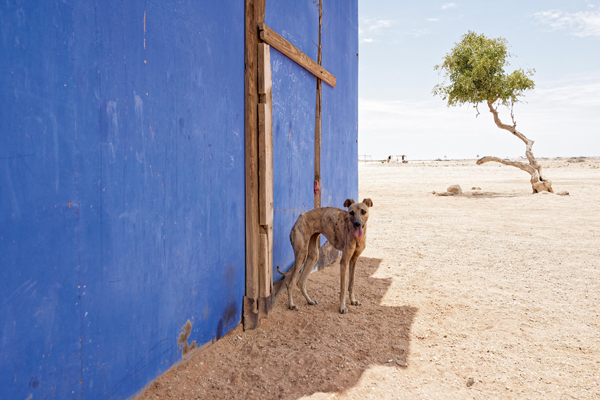
Margaret Courtney-Clarke, Gottlieb plays traditional Damara music at the funeral of Ouma Juliana ǂÛ-khui ǁAreses on the family farm beneath the Dâures. Uis District, Erongo Region, 6 December 2014
© the artist
Except perhaps for a thread of elegance that runs through most of her work, not any of Margaret Courtney-Clarke’s earlier photography prepared me for the work in her book Cry Sadness into the Coming Rain (2017). No hint of what she has done here could I find in my memory of our collaborations of the late seventies. Nor could I link what she has done in the past few years in Namibia with her photography on the art of African women in traditional societies. Fifteen years of work, unaccompanied journeys into remote parts of Africa, hardships, fevers and great risks resulted in three seminal and definitive books, yet all of them differed fundamentally from what we have here.

Margaret Courtney-Clarke, While Marta Rooinasie lives out her day in the nearby Klein Spitzkoppe Mountain digging for tourmalines, her Africanis dog Skrikkie (Afrikaans for “little fright”) guards her home, poultry and pigeons. Erongo Region, 9 January 2015
© the artist
Margaret returned to Namibia, the country of her birth and upbringing, in 2008 to live in Swakopmund on the edge of the Namib desert. Recovering from a life-threatening illness and the effects of its treatment, one might be forgiven for thinking that she would adopt a quiet life and write her memoirs. Instead, in photographs quite unlike anything she (or others) had done before, she embraced the reality of the Namib desert and its people with an extraordinary energy, acuity and devotion.

Margaret Courtney-Clarke, Ashanti Gaises was born and raised in Khorixas in north-eastern Namibia and has moved south with her baby in search of work. She drags a bag of cardboard boxes from an illegal dump on the outskirts to the DRC. Swakopmund, 4 March 2014
© the artist
The photographs she produced are about existence. They come from an awareness of the fragility of her own existence and from a symbiotic grasp of the ancient rhythms of the desert and the coast, the ways of life of its people, the traces of their passing and the seemingly inexorable advance of corporate and mining development. The photographs are bare of nostalgia, fat or facile certainties. They are eloquent of raw existence and offer faint glimmers of hope, of life scratched from an appallingly inhospitable terrain in the face of overwhelming societal transition. Yet these photographs attain a searing grace which is in no sense false to the reality but is, on the contrary, a rare synthesis of what is there with an intensely heightened and uncompromisingly honest vision.

Margaret Courtney-Clarke, A morning at the “amphitheater” in the sand dunes. Dorob National Park, 26 April, 2016
© the artist
Margaret’s relationship with the people she has photographed in this work is practical and intimate, never patronising, almost that of family rather than of compassionate observer. It is of a piece with the wholeness of her embrace. Using the sand of the desert she built a dwelling of sandbags with a family who had no home. She is a trusted friend of the women and children who scavenge the garbage dumps. She puts children into school and confronts municipal officials over their treatment of landless people. Deep into the desert she goes to friends and she knows their life. She celebrated her birthday with a family of peasant farmers who slaughtered a goat in her honour. When she heard of two children who had died of snakebite, she raised money for their coffins and travelled 230 kilometers on a rough desert track to be at their funeral.

Margaret Courtney-Clarke, Tattered by wind and burnt by the sun, an effigy made by Tolikie Dausab is meant to attract buyers/tourists to his pile of rose quartz stones on the side of the road. A road grader returns to camp for the night. Uis District, Erongo Region, 8 August 2015
© the artist
In her earlier work Margaret’s concern was the art of African women. In this work her involvement is with the people themselves and their place. Like a pulse in the background her involvement throbs with anger and love. Anger at the stunting of lives, the blunting of hope, the desecration of the Namib and her own frailty, when there is so much to tell. Not the least of which is love.
David Goldblatt is a photographer based in Johannesburg. This text is reproduced from the foreword to Margaret Courtney-Clarke’s photobook Cry Sadness into the Coming Rain, published by Steidl in 2017.